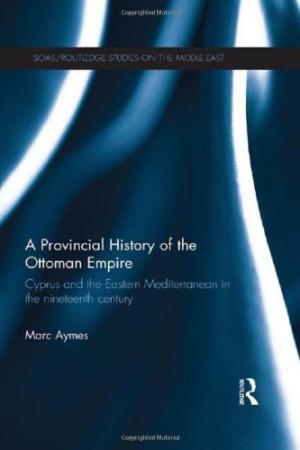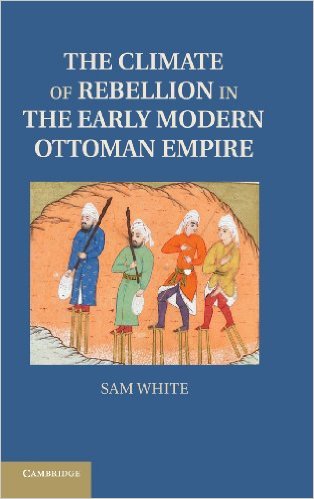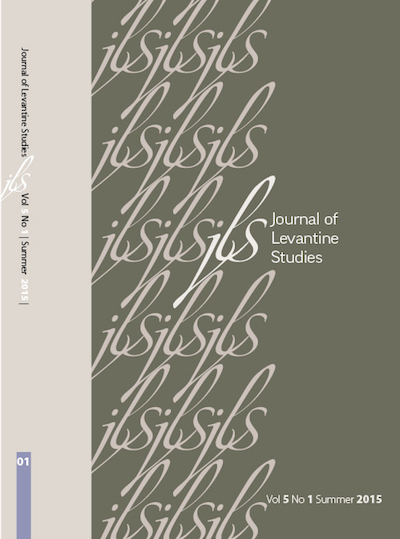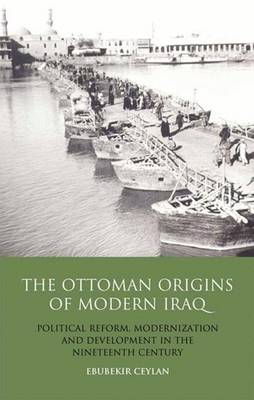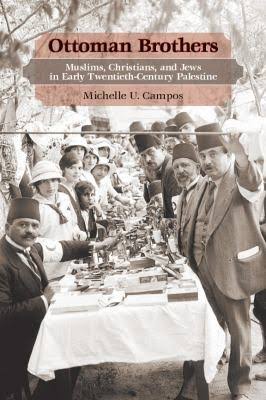-
Add to cartQuick view
Elizabeth F. Thompson. Justice Interrupted: The Struggle for Constitutional Government in the Middle East. Cambridge, MA: Harvard University Press, 2013. 432 pp.
Elizabeth F. Thompson. Justice Interrupted: The Struggle for Constitutional Government in the Middle East. Cambridge, MA: Harvard University Press, 2013. 432 pp.
$5.00Free!Add to cartQuick view -
Add to cartQuick view
Marc Aymes. A Provincial History of the Ottoman Empire: Cyprus and the Eastern Mediterranean in the Nineteenth Century. Oxon: Routledge, 2013. 240 pp.
Marc Aymes. A Provincial History of the Ottoman Empire: Cyprus and the Eastern Mediterranean in the Nineteenth Century. Oxon: Routledge, 2013. 240 pp.
$5.00Free!Add to cartQuick view -
Add to cartQuick view
Sam White. The Climate of Rebellion in the Early Modern Ottoman Empire. Cambridge: Cambridge University Press, 2013. 352 pp.
Sam White. The Climate of Rebellion in the Early Modern Ottoman Empire. Cambridge: Cambridge University Press, 2013. 352 pp.
$5.00Free!Add to cartQuick view -
Add to cartQuick view
The Rear Side of the Front: Gaza and Its People in World War I
Free!During the First World War, the city of Gaza, a regional hub of forty thousand souls and a major market and exporter of grains, turned into a battlefield. While the military and political consequences of this arena are well researched, this article examines its civil and social aspects as well, in order to better understand the story of the First World War in Palestine. Using both British and Ottoman documentation alongside civil accounts and memoirs, the article discusses the reasons, methods, and effects of the city’s complete evacuation and the massive destruction of its physical environment. The civil perspective of the war reflected in the fate of Gaza poses a challenge to common chronological and spatial presumptions about the war itself, and it allows a rethinking of the Mandate period in the light of postwar circumstances.
Add to cartQuick view -
Add to cartQuick view
Erotics of the Exotic: Orientalism and Fictionalization of the Mooress in the Early Modern Mediterranean
Free!The representation of women in the realm of Islam in early modern Spanish literary, religious, historical, and political texts provides a very significant key to the perception of the “Other” in Spain. These women were categorized according to their radically different circumstances: in Spain they were Moriscas (where they were the objects of an internal colonization), but in the Ottoman Empire (which was seen as a threat to Christian Europe) they were Moras and Turcas. Muslim women were systematically portrayed as highly sexualized subjects, sometimes in combination with the mystified harem and the slave market. In a tone ranging from contempt and disgust to ravishing desire, Muslim women were depicted as sensual and sexually accessible creatures. This Occidental fantasy was a means of establishing an imaginary domain over a powerful rival. Such representations of women were themselves essentially Orientalist, even when they occurred prior to the colonial and postcolonial relationship between the West and the Orient, suggesting that Orientalism itself ought not to be exclusively linked with colonialism and postcolonialism.
Add to cartQuick view -
Add to cartQuick view
Imperial Ottoman Identity in Salonica at the End of Ottoman Rule
Free!This paper examines the development of imperial Ottoman identity at the end of Ottoman rule in Salonica. This identity transcended communal divisions and antagonized separatist nationalisms fostered by neighboring Balkan states. It is argued that this identity was promoted by the Young Turk Revolution of 1908, at least rhetorically, and more importantly, by the cosmopolitan setting of Ottoman port cities. As imperial Ottoman identity was developed within Salonica’s pre/proto-nationalist and multicommunalframework, this paper focuses on loci conducive to an imperial Ottoman imaginary, such as newspapers, urban landscape, civic festivities and events, and schools. Newspapers promoted imagination of a common Ottoman community, articulated Ottomanness, and depicted Salonica as a shared city. The conviviality of Salonica’s communities was experienced in entertainment sites and public places, while Salonicans experienced a magnificent multiplicity of architectural styles and encountered the diversity of religions, languages, and cultures in their daily life. Political events, such as the Young Turk Revolution, and civic festivities, such as the visit of Sultan Mehmed V, mobilized Salonicans across communal boundaries. High-quality and foreign schools had become loci of embryonic Ottoman cross-national elites. In tandem with the development of imperial Ottoman identity, Balkan nationalisms were competing for the minds and souls of Salonicans with their antagonism culminating in the Balkan Wars and the demise of Ottoman rule and identity.
Add to cartQuick view -
Add to cartQuick view
Review Essay: The Transforming Landscape of Turkey’s Alevi Politics
Free!Review Essay:
Elise Massicard, The Alevis in Turkey and Europe: Identity and Managing Territorial Diversity. New York: Routledge, 2013. 255 pp.Necdet Subaşı, Alevi Modernleşmesi: Sırrı Faş Eylemek. İstanbul: Timaş, 2008. 320 pp.Add to cartQuick view -
Add to cartQuick view
Ebubekir Ceylan, The Ottoman Origins of Modern Iraq: Political Reform, Modernization and Development in the Nineteenth-Century Middle East. Library of Ottoman Studies, London and New York: I. B. Tauris, 2011, 297 pp.
Ebubekir Ceylan, The Ottoman Origins of Modern Iraq: Political Reform, Modernization and Development in the Nineteenth-Century Middle East. Library of Ottoman Studies, London and New York: I. B. Tauris, 2011, 297 pp.
$5.00Free!Add to cartQuick view -
Add to cartQuick view
Intercultural Meeting Places of Minorities in Ottoman Salonica
Free!The multicultural physiognomy of Ottoman Salonica has become a point of reference. Its contrast with the negative attitude shown by some of the local “homogenous” population toward foreign immigrants today has urged me to investigate the daily opportunities for social mixing enjoyed by the ethnic communities of Ottoman Salonica. I examine some of their meeting places and how these Ottoman institutions functioned so that members of separate religious communities often defined themselves through the common urban identity of their multicultural milieu.
Add to cartQuick view -
Add to cartQuick view
Michelle U. Campos. Ottoman Brothers: Muslims, Christians and Jews in Early Twentieth-Century Palestine. Stanford: Stanford University Press, 2011. 360 pp.
Michelle U. Campos. Ottoman Brothers: Muslims, Christians and Jews in Early Twentieth-Century Palestine. Stanford: Stanford University Press, 2011. 360 pp.
$5.00Free!Add to cartQuick view -
Add to cartQuick view
Cultural Trends of Urbanization in Salonica: Ottoman Poetic Genres of the Ritual Songs of the Ma’aminim
Free!The “Ma’aminim,” known derogatorily as “Dönme,” followed in the footsteps of their messiah—Sabbatai Tsevi—and broke out of the boundaries of Jewish society by converting to Islam during the 1680s. They established their center in Ottoman Salonika. While outwardly being fully Muslim, the Ma’aminim secretly developed and observed a hybrid messianic religion consisting of ritual practices and beliefs that were a combination of their unique Sabbatian faith, their Sephardi Jewish origins, and elements appropriated from their non-Jewish Ottoman surroundings. The aim of this paper is to illuminate the songs of the Ma’aminim—perhaps the most crucial inner-communal source available to us—in light of the context in which they were created. The main tool for contextualizing will be the examination of two popular, previously unnoticed Ottoman poetic genres to which many of the Ma’aminim songs belong: şarkıand türkü. The paper claims that the extensive use of these genres reflects common cultural preferences among the Ma’aminim and wider cultural trends of the time in which the songs were created, trends that were related to changes in urban Ottoman society. This focus on these genres will demonstrate the importance of considering the Sabbatian mystical sources as a historical document and will offer a cross-cultural perspective for pursuing further research on these unique texts.
Add to cartQuick view -
Add to cartQuick view
Unrest at the Gates of Aleppo: British Perspectives on the Bedouin Challenge to Public Security in Northern Syria, 1848-1913
Free!The political situation in the eastern Arab world during the colonial period was subject not only to the interests of the great powers of East and West but also to disturbances caused by tribal Arabs who found refuge in the desert. Although there has been much research on bedouin of both the nomadic and the sedentary tribes of Syria and its hinterland—mostly drawing on ethnographic aspects—little has been written on the tribes as a challenge to political stability. Aleppo is of special interest since it was an important city close to the desert frontier and was under permanent threat of bedouin raids. The city also was and still is a place of sectarian diversity, second only to Beirut, and all too often the Christian population was wedged between the Ottoman government and nomadic tribes. Dealing with the bedouin thus touches all aspects of an eroding Ottoman power that affected Levantine urban life and sectarian coexistence. This paper draws on previously unpublished archival sources of the British Consulate in Aleppo.
Add to cartQuick view
- Home
- About JLS
- Issues
- Vol. 9 No. 1 | Summer 2019
- Vol 8 No 2 Winter 2018
- Vol. 8, No. 1: Summer 2018
- Vol. 7, No. 2: Winter 2017
- Vol. 7, 1: Summer 2017
- Vol. 6, Summer/Winter 2016
- Vol. 5, No. 2 Winter 2015
- Vol. 5, No. 1 Summer 2015
- Vol. 4, No. 2 Winter 2014
- Vol. 4, No. 1 Summer 2014
- Vol. 3, No. 2 Winter 2013
- Vol. 3, No. 1 Summer 2013
- Vol. 2, No. 2 Winter 2012
- Vol. 2, No. 1 Summer 2012
- Vol. 1, No. 2 Winter 2011
- Vol. 1, No. 1 Summer 2011
- Blog
- dock-uments
- Subscribe
- Submit
- Contact

